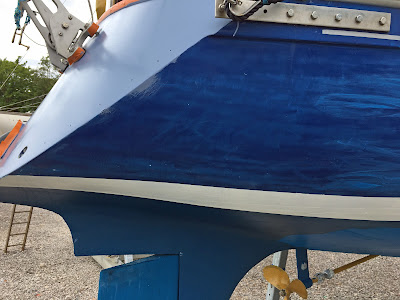And long days, at least for me, 10.5 hours on the job after an hour and threequarters traveling down on Friday and 7.5 hours plus the return trip today after staying at the RAFYC overnight to limit travelling to about 15 minutes each way.
The damage is not as bad as it first appeared although it still requires a full repaint which was confirmed by a pro working on the next boat.
Firstly the damaged is fairly localised and the power washer exposed most of it, I was able to peal and chip off more, mainly on the smaller areas, but the the rest of the paint close to the waterline was still firmly attached.
Secondly the pin pick bubbles / blisters and holes visible just above the boot line only penetrated the very thin top coat - so thin that if you press moderately hard 320 wet and dry used wet goes through the top coat in about three strokes. It would appear that the weed got that far before I was able to get it off and the holes were not big enough for water to make things worse.
Given both of these I was able to give up a possible approach of stripping a 3 - 4 inch band the length of the boat just above the boot line and be a more targeted which saves a lot of time as although the top coat is thin and some of the undercoat & primer not well attached where it is attached it is a devil to get off and very difficult to get a clean edge.
To hopefully stop this happening again the boot line needs to be raised (again) and given it is already too wide that means the bottom has to come up as well as the top. Specialist power tools would help but I don't have them.
The jobs in this session were to clean off as much crud as possible from the topsides, take the edges of damaged areas back to sound paint and prepare the gloss above the boot line for priming whilst removing any pin holes in the top coat or further down. The damaged areas and the area under the new boot line then have to be primed and the damages areas given multiple undercoats to bring the level up to the existing gloss. During this sesson I did not prepare the entire topside for painting due to time constraints and instead spent some time on the boot line - that will need multiple coats on the top to give protection and on the bottom for the blue to effectively cover the white. Although each coat does not take long the masking is a pain. When finished the entire underwater section will get a coat of antifoul to match things up and, with the three coats given last winter, should last me through next season hopefully saving a lift out and block off this winter.
 |
Port side forward as damaged pieces tidied up and the strip above
the old boot line prepared for priming.
|
 |
Port side aft at the same time. The bare looking patch in the boot
line was probably caused by something I hit earlier in the
year, it might have been a particularly sturdy pot marker but
it was dark at the time and although on deck I could not see
it in the dark (this was not the pot markers I became entangled
with in the dark of St Ives). |
 |
| And the other side. |
 |
The floor mop is very handy for cleaning the topside from ground
level and the bottom from the dinghy. |
 |
Raising the bottom of the boot line, 1st coat. The top is masked
ready for a coat of Primacon with gaps to allow for priming the
damaged pieces most of which will end up under the anti-fouled
boot line but with small bits above. Some but alas not all of the
irregulates in the line were removed after the pic but before painting,
hopefully it should be correctable on the next couple of coats. |
The area above the boot line and the damaged areas are now primed and a first coat of white antifoul applied to the boot line but I omitted to take pictures before leaving.
.JPG)


.jpg)

.JPG)





















